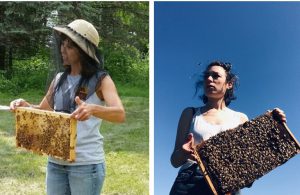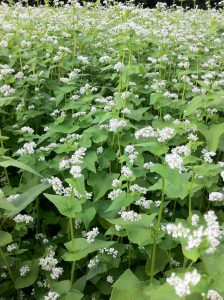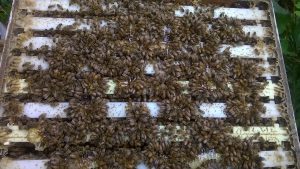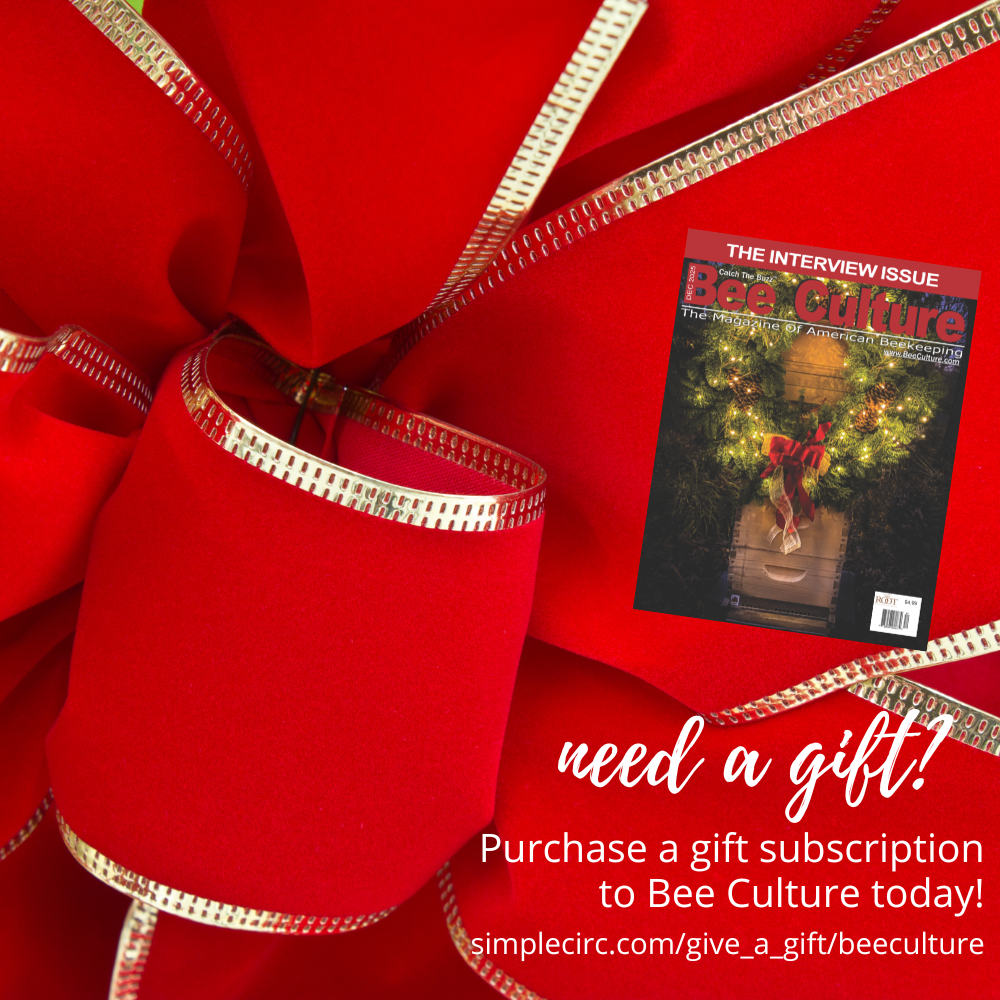
Becky Masterman led the UMN Bee Squad from 2013-2019. Bridget Mendel joined the Bee Squad in 2013 and has led the program since 2020. Photos of Becky (left) and Bridget (right) looking for their respective hives. If you would like to contact the authors with your own honey production success stories or other thoughts, please send an email to
mindingyourbeesandcues@gmail.com
Honey Time: Part 2
Becky Masterman & Bridget Mendel
Extracting scientific information about a good honey crop is a super great way to wrap up your bee season. There’s much to comb through, from flowering plants, to apiary location, to weather, climate change and of course, bees.
New beekeepers may plan on sustaining their bees with their backyard plantings, but, upon first observing those foragers emerge from the hive entrance and zip up and out over the tree line, it becomes clear that a bigger radius is indeed traversed (approximately two to three miles; further if necessary).

Creating bee pastures within two miles of your apiaries contribute to increased honey production and bee health. This field of buckwheat
was planted for the University of Minnesota Bee Lab by the UMN
Landcare team. Photo Credit: Rebecca Masterman
While honey bees prefer to stay closer to home, their success at honey production is due to their ability to locate and recruit their sisters to what’s flowering on any given day. Couvillon et al. (2014) recorded and interpreted forager waggle dances (aka recruitment communication to fellow foragers) and reported that foraging distances increased in Summer months in the UK. They concluded that increased foraging distances meant more local, convenience-food was scarce. These data reflect specific apiary locations and we would expect that based on local resource availability (like planting bee pastures full of season-long nectar and pollen producing flowers close to your apiaries), the distances honey bees travel for food could change. So, if you want to keep your bees closer to home and save them some effort, figure out a way to plant more flowers within a two mile radius of your apiaries.
Timing is everything when it comes to honey production and knowing what is about to flower is key to good management. The University of Minnesota Bee Lab’s Dr. Marla Spivak thinks that the best beekeepers are also good botanists. She described how they watch the plants for growth and anticipate blooms, getting their supers on before nectar flows. Knowing the timing of the different flowering plants and trees in your area is understanding their phenology. Plant phenology is the timing of a plant’s life history, including nectar production, and it is influenced by sunlight, water, soil and plant health. You might be lucky if you have a bee club that records the phenology of bee plants in your area. If not, think about crowdsourcing the information with beekeepers in your area.
To forage, bees need the right conditions, including sunlight and temperature. Unlike in Camelot, in most places rain also falls during the day and will keep your bees at home. Luckily, your bees have a plan for precipitation events. Using Radio Frequency Identification (RFID) technology, a research team in China reported not only that honey bees’ foraging was impacted by humidity, precipitation, temperature and barometric pressure, but there was a significant increase in foraging before a rainy day (He et al., 2016).
Beekeepers worry about their bees in normal weather conditions, but emerging climate change data adds a new layer of concern. Plant phenology can be disrupted by climate change and although increases in temperatures can increase nectar production in some plants, temperature increases along with water stress can also have negative effects on important nectar producing plants (Takkis et al., 2015). Researchers in Chile published a detailed study in collaboration with beekeepers and reported honey production declines over the last decade (Gajardo-Rojas et al., 2022). They also shared that they combated the production decline by planting native plant species and increasing migration of their bees between floral sources.
Flowers, weather and climate change aside, if you do not have a strong, healthy population of bees living in your hives, you won’t have thousands of nectar gatherers at the ready to visit flowers. We understand that bee health is impacted by pests, diseases and pesticides. Canadian researchers reported on the potential negative honey crop impact on colonies infested with Varroa destructor (Emsen et al., 2014) with an average of approximately 20 lbs less honey produced per hive in highly infested colonies. On a brighter note, researchers in Australia, prior to the arrival of Varroa, examined the impact of miticide treatment on foraging (Colin et al., 2021). They applied either thymol or tau-fluvalinate in late Fall (Spring in North America) and asked if the application of the chemicals impacted food storage or colony populations. They did not report any significant impacts as a result of the application of the treatments.
Aside from the obvious deadly impacts of pesticide exposure to colony populations, non-lethal consequences can also decrease honey production in colonies. A recent publication reported that foraging behaviors were decreased after a nonlethal exposure to a neonicotinoid (Ohlinger et al., 2022). Although recruitment behaviors (waggle dancing) decreased, the differences were not significant when compared to controls.
Abundant, clean, nectar producing flowers, healthy bees and great weather (for the plants and the bees) all play a part in honey production. While many beekeepers plant their bees down in a site and hope for the best, the honey bee champions are beekeepers who ensure that their bees are healthy and are working to coordinate with willing landowners to install bee pastures close to their apiaries. Here’s to this season’s honey, and here’s to more next time!

Strong, healthy colony populations are essential to great honey production. Photo Credit: Rebecca Masterman
Acknowledgment
The authors would like to thank Dr. Marla Spivak for helpful edits and suggestions.
References
Colin, T. Forster, Casey, CC, Westacott, J, Wu, X, Meikle, WG, Barron, AB (2021) Effects of late miticide treatments on foraging and colony productivity of European honey bees (Apis mellifera). Paris: Springer Paris. Apidologie, Vol.52 (2), p.474-492.
Couvillon, MJ, Riddell Pearce, FC, Accleton, C, Fensome, KA, Quah, SKL, Taylor, EL, Ratnieks, FLW. (2014) Honey bee foraging distance depends on month and forage type. Paris: Springer Paris. Apidologie, Vol.46 (1), p.61-70.
Emsen, B, Guzman-Novoa, E, and Kelly, PG. (2014) Honey production of honey bee (Hymenoptera: Apidae) colonies with high and low Varroa destructor (Acari: Varroidae) infestation rates in eastern Canada, New York, USA: Cambridge University Press. Canadian Entomologist, 2014, Vol.146 (2), p.236-240.
Gajardo-Rojas, M., Muñoz, AA, Barichivich, J, Klock-Barría, K, Gayo, EM, Fontúrbel, FE, Olea, M, Lucas, CM, Veas, C. (2022) Declining honey production and beekeeper adaptation to climate change in Chile SAGE Publications Progress in physical geography.
He, XJ, Tian, LQ, Wu, XB, Zeng, ZJ. (2016) RFID monitoring indicates honeybees work harder before a rainy day. HOBOKEN: Blackwell Publishing Ltd. Insect science, 2016, Vol.23 (1), p.157-159.
Kaur, N, Chhuneja, PK, Singh, J, Choudhary, A, Dhillone, SK. (2021) Effect of weather factors and nitrogen application on nectar secretion and honey production potential in sunflower. Journal of Agrometeorology, Vol.22 (4), p.457-468.
Ohlinger, BD, Schürch, R, Durzi, S, Kietzman, PM, Silliman, MR, and Couvillon, MJ. (2022). Honey Bees (Hymenoptera: Apidae) Decrease Foraging But Not Recruitment After Neonicotinoid Exposure. Journal of Insect Science, Volume 22, Issue 1,16, https://doi.org/10.1093/jisesa/ieab095
Takkis, K, Tscheulin, T, Tsalkatis, P, and Petanidou, T. (2015) Climate change reduces nectar secretion in two common Mediterranean plants. AoB Plants.7:plv111. doi: 10.1093/aobpla/plv111. PMID: 26374517; PMCID: PMC4614813.










